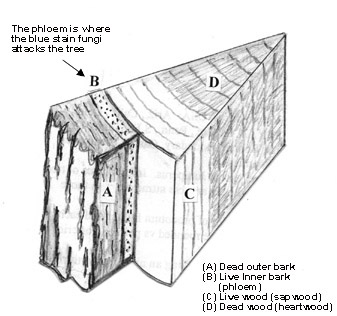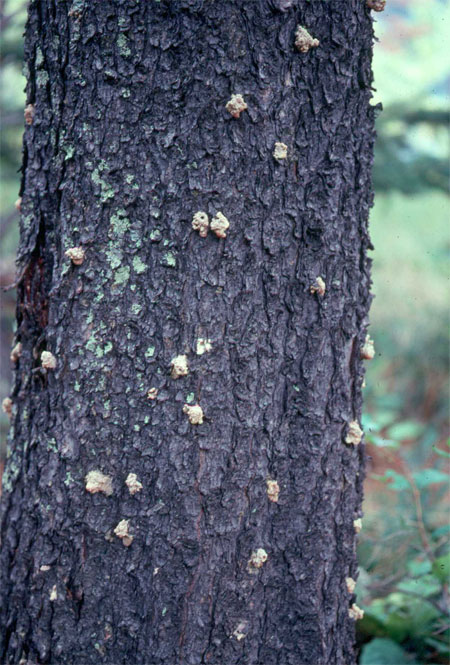Battle in the bark
 |
It isn’t easy for a mountain pine beetle to successfully colonize a tree. It must avoid predators and tree defenses, and compete with other organisms for space within the tree. Young beetles must be able to survive cold winters and parasitising from other organisms. In fact, a whole “battle in the bark” occurs before beetles are able to produce a healthy next generation.
Trees defences
When a mountain pine beetle attacks a pine tree, it is not always successful. Pine trees have defence mechanisms that can prevent the beetle from colonizing the tree. The very highest tree branches receive moisture and nutrients through “pitch” that is carried up the tree through its vascular system (the “sapwood”). In order to get the pitch all the way to the top, pressure is maintained in the vascular tubes. When a beetle tunnels through the bark and into the sapwood of the tree, this pressure causes the pitch to pour out through the hole the beetle has created. Often, the beetle is caught in the sticky pitch, and is killed before it can dig galleries and reproduce.

Diagram of a tree wedge showing the dead outer bark, the live inner bark (or phloem), the live wood (or sapwood) and dead wood (or heartwood). © Malcolm M. Furniss |
 The bubbles of resin are called “pitch tubes”.
The bubbles of resin are called “pitch tubes”.© Parks Canada / Heather Dempsey |
Mountain pine beetles have developed a number of strategies to avoid being “pitched out”. First, they use pheromones that coordinate the attack of many beetles on a tree at once. Although some of the beetles will be caught up in the pitch, some are able to avoid it and successfully begin to dig galleries. The action of digging galleries disrupts the vascular system and slows down the flow of pitch.
Mountain pine beetle also carry Ophiostoma, or “blue stain fungi”. Adults carry the fungi on a special structure in their mouthparts, and when they begin chewing the sapwood, the fungi quickly multiplies and further disrupts the vascular system, preventing the tree from releasing pitch into the area.
Predators and competitors
Mountain pine beetle are preyed upon or parasitized by a number of organisms including:
- birds (especially woodpeckers);
- other beetles, flies, and wasps;
- internal parasitic worms (nematodes).
 By spending time under the bark, beetles are less likely to be eaten by predators. However, woodpeckers use their powerful beaks to drill through the bark and eat the beetles. In an area experiencing a beetle outbreak, woodpeckers can eat as many as 30% of the population! © Parks Canada |
Some predators like nuthatches and checkered beetles will attack adult beetles during flight or while on the outside of the tree bark. Other animals like parasitic wasps will inject their eggs into the mountain pine beetle galleries, to feed on beetle larvae and mature in the protection of the galleries.
Even if the larvae survive predators, they must compete for food and space not only with each other, but also with the larvae of other beetles like the round-headed woodborers. These woodborers can destroy entire mountain pine beetle broods.
Surviving the elements
Mountain pine beetle spend the majority of their life under the bark of pine trees. Once the adults lay the eggs in the galleries, eventually the eggs hatch to larvae that feed on the trees' phloem over the winter. Mountain pine beetle have evolved special adaptations that allow them to survive winter conditions. By staying under the bark, they are less susceptible to the cold and wind. In addition, the beetle produces glycols or “sugars” in their blood that act as an antifreeze, preventing them from freezing. To overcome the antifreeze and kill the larvae, winters have to be very cold and very long.
To learn more about the cold hardiness of mountain pine beetle larva, visit this Canadian Forest Service website.
- Date modified :
